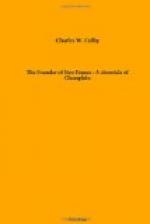Lacking vegetables, Quebec fed itself in part from the river and the forest. But almost all the food was brought from France. At times there was game, though less than at Port Royal. The river supplied eels in abundance, but when badly cooked they caused a fatal dysentery. The first winter was a repetition of the horrors experienced at St Croix, with even a higher death-rate. Scurvy began in February and lasted till the end of April. Of the eighteen whom it attacked, ten died. Dysentery claimed others. On June 5, 1609, word came that Pontgrave had arrived at Tadoussac. Champlain’s comment is eloquent in its brevity. ’This intelligence gave me much satisfaction, as we entertained hopes of assistance from him. Out of the twenty-eight at first forming our company only eight remained, and half of these were ailing.’
The monopoly granted to De Monts had now reached its close, and trade was open to all comers. From 1609 until 1613 this unrestricted competition ran its course, with the result that a larger market was created for beaver skins, while nothing was done to build up New France as a colony. On the whole, the most notable feature of the period is the establishment of close personal relations between Champlain and the Indians. It was then that he became the champion of the Algonquins and Hurons against the Iroquois League or Five Nations, inaugurating a policy which was destined to have profound consequences.
The considerations which governed Champlain in his dealings with the Indians lay quite outside the rights and wrongs of their tribal wars. His business was to explore the continent on behalf of France, and accordingly he took conditions as he found them. The Indians had souls to be saved, but that was the business of the missionaries. In the state of nature all savages were much like wild animals, and alliance with one nation or another was a question which naturally settled itself upon the basis of drainage basins. Lands within the Laurentian watershed were inhabited mainly by Algonquins and Hurons, whose chief desire in life was to protect themselves from the Iroquois and avenge past injuries. The Five Nations dwelt far south from the Sault St Louis and did not send their furs there for the annual barter. Champlain, ever in quest of a route to the East, needed friends along the great rivers of the wilderness. The way to secure them, and at the same time to widen the trading area, was to fight for the savages of the St Lawrence and the Ottawa against those of the Mohawk.
And Champlain was a good ally, as he proved in the forest wars of 1609 and 1615. With all their shortcomings, the Indians knew how to take the measure of a man. The difference between a warrior and a trader was especially clear to their untutored minds, they themselves being much better fighters than men of commerce. Champlain, like others, suffered from their caprice, but they respected his bravery and trusted his word.




